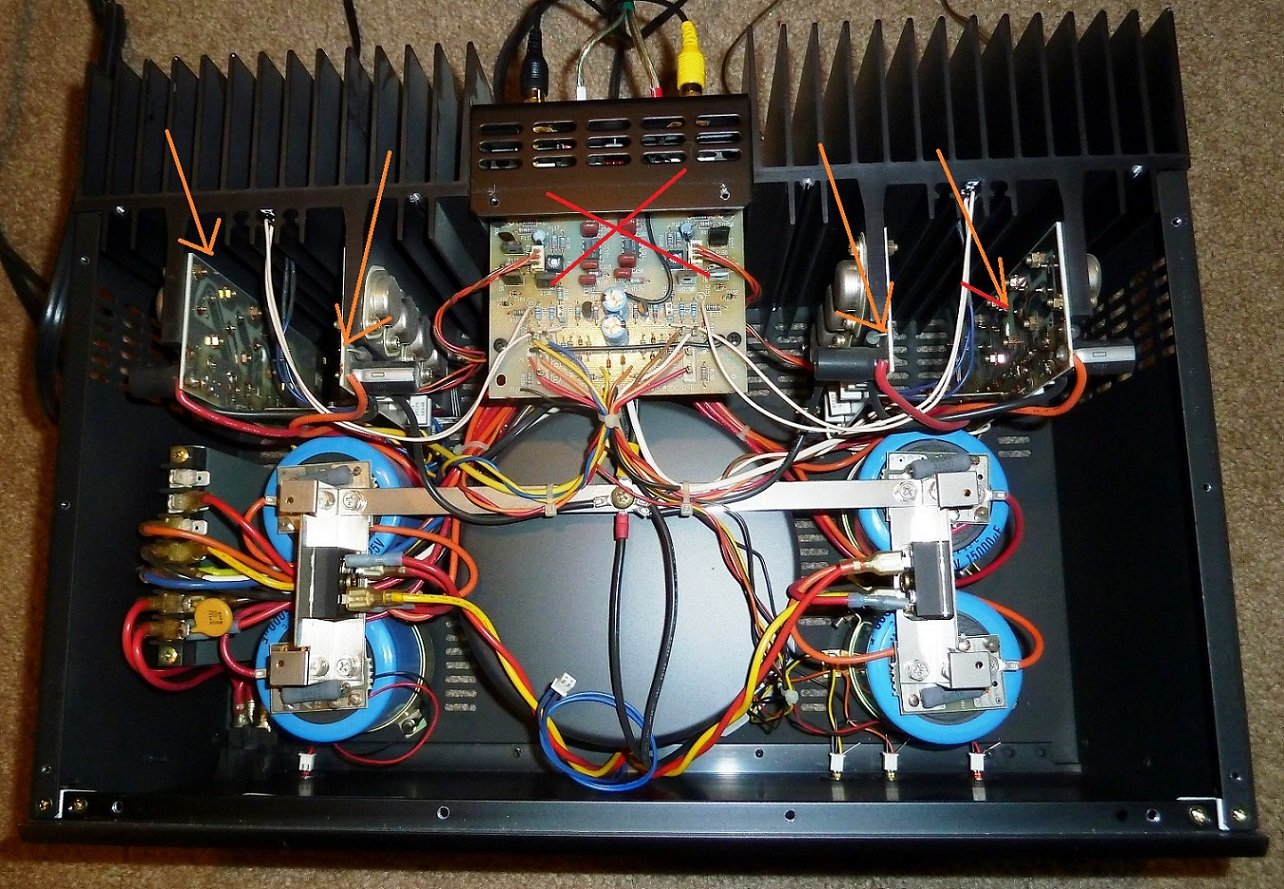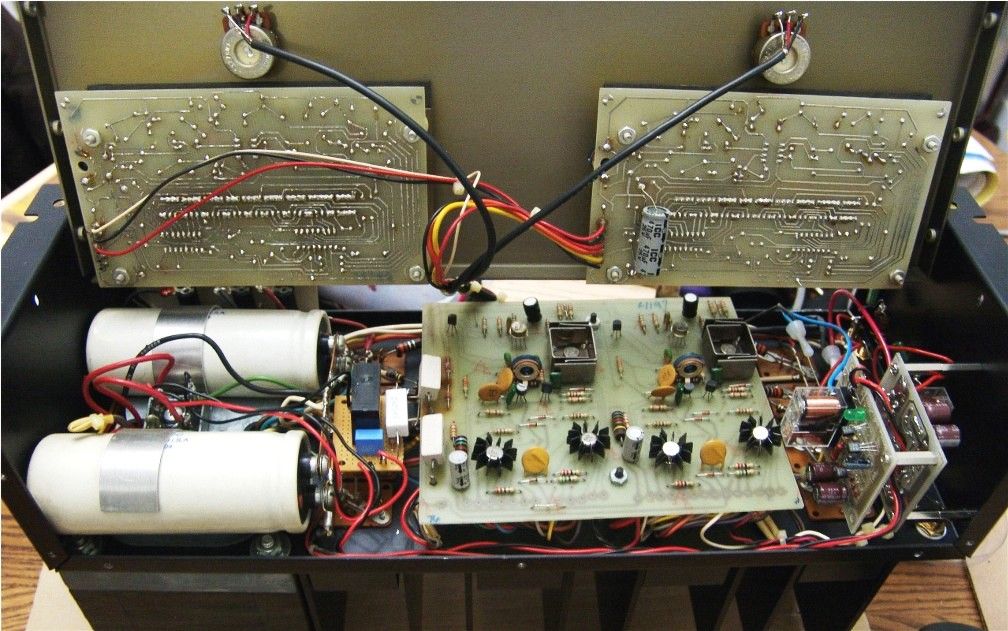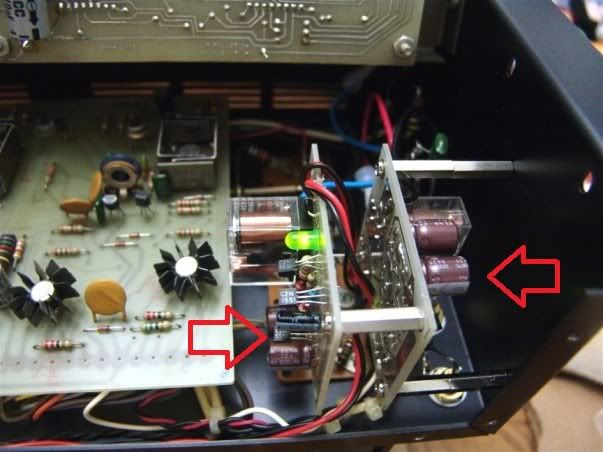Test points for BIAS and DC on Adcom GFA-555 II.

Mystery
Posts: 2,546
I got an Adcom GFA-555 II just last night and it's not working.
I can't find test points TP201, TP301, TP251 and TP351 in the service manual and they are not labeled on the board. :mad:
Are the two pins highlighted in red the test points?
If yes, are the two points together for one channel?
Thanks.
I can't find test points TP201, TP301, TP251 and TP351 in the service manual and they are not labeled on the board. :mad:
Are the two pins highlighted in red the test points?
If yes, are the two points together for one channel?
Thanks.
Klipsch RB81, KG3.5, B&W DM602.5, Polk.
Subwoofers: Klipsch RW10, Triad ProSub Bronze.
Post edited by Mystery on
Comments
-
Um, if its not working, Bias and DC offset won't matter.
Regardless, DC offset is measured at the speaker terminals. I don't think there is an adjustment on the Adcoms.
Bias is usually measured on test points near the output transistors or on the legs of the transistors themselves. I don't think those are the bias test points, but those are the variable resistors you need to adjust. Look on the boards that connect to the metal can output transistors.
Be VERY careful when dealing with these test points. A slip of the probe can short out and fry whole output stage in a heartbeat!
EDIT: Looking at some other photos of that amp, I think your test points are the long (single, unconnected) metal rods sticking off of each of the output boards. You will test between the two boards for each channel. One side is the NPN the other side is the PNP. Use alligator clips if you can to avoid slips.For rig details, see my profile. Nothing here anymore... -
Thanks Bill.
Here is a picture of the amp.
I think I need to look at the boards that are pointed with the arrow.
Klipsch RB81, KG3.5, B&W DM602.5, Polk.
Subwoofers: Klipsch RW10, Triad ProSub Bronze. -
Yes, each of those boards should have a single metal pin sticking out, no wires attached. Test voltage across the pins of the right channel boards and left channel boards. If you get a good look in there, they should be labeled as J301, etc. Just be careful, don't touch anything else. If you don't have alligator clips, I might think twice.For rig details, see my profile. Nothing here anymore...
-
I checked all the fuses' values and it was a mix.
One was 5A which was blown 5A, two were correct 7A (AGC 7A-250V/312) and one was 6A.
I replaced the two 5A and 6A with 7A and now it is working fine.
I found the test points. They are small metal bars on the vertical boards.
However, setting bias is so weird.
When I adjust the resistor, it changes value but automatically comes back to around zero soon after when no input is connected.
Then I connected input signal and played a track and bias went up and down depending upon the music, around 14 to 18mV.
So basically, can't adjust bias.
Also checked DC voltage and it was close to 0 fluctuating sometimes to .001 so I guess it's good.
I read this amp doesn't have speaker protection so that's something to read next.
Here are the test points for reference highlighted in red circle.
However, they are not numbered TP201, TP301, TP251 and TP351 as mentioned in the service manual.
The numbers were J### something.


Thanks for comments.
Klipsch RB81, KG3.5, B&W DM602.5, Polk.
Subwoofers: Klipsch RW10, Triad ProSub Bronze. -
Bias should only be measured with no signal, after the amp is warmed up to full operating temps. Don't worry about what its doing when a signal is playing.For rig details, see my profile. Nothing here anymore...
-
Okay thanks.
How about protecting speakers from this amp?
It doesn't have speaker protection circuit.
Can it be added inside or something external like in-line fuse work?
Klipsch RB81, KG3.5, B&W DM602.5, Polk.
Subwoofers: Klipsch RW10, Triad ProSub Bronze. -
Okay thanks.
How about protecting speakers from this amp?
It doesn't have speaker protection circuit.
Can it be added inside or something external like in-line fuse work?
Not an easy addition. There are plenty of DIY sites that talk about it, but it may be beyond what you want to do. It is definitely a drawback of that amp.For rig details, see my profile. Nothing here anymore... -
I see. I have speaker selector with amp protection but need something with speaker protection as I think the speaker selector only has a resistor and no protection on DC voltage.

I'm still bothered by the bias pots.
Turning R119 and R169 doesn't change mV readings and even if it changes, it resets back to 0.
I'll try again and see how that goes.
Klipsch RB81, KG3.5, B&W DM602.5, Polk.
Subwoofers: Klipsch RW10, Triad ProSub Bronze. -
http://akdatabase.org/AKview/albums/userpics/10004/Adcom%20GFA-555II%20Service.pdf
https://groups.google.com/forum/#!topic/rec.audio.misc/sRdukGzkSfk
First addy is the service manual. The second is a REALLY good read. I've been changing out passives in my 555 and have noticed SOME difference in sound quality(for what I've got). MOST of it has been done for reliability reasons though. Mine NEVER gets powered down unless I'm modding it. I'd suggest you do the same, unless you're worried about the electric meter.Monitor 12's-RDO's and XO's done!
Onkyo TX-SR705 AVR
Adcom GFA-555 for power(being reborn, as I can afford it)
Onkyo DX-C730 changer
Onkyo CP-1057F table W/Grado cartridge
CS300 center
M4's for rears
LG 47" LCD
ROKU streaming gizmo -
I see. I have speaker selector with amp protection but need something with speaker protection as I think the speaker selector only has a resistor and no protection on DC voltage.

I'm still bothered by the bias pots.
Turning R119 and R169 doesn't change mV readings and even if it changes, it resets back to 0.
I'll try again and see how that goes.
Are you sure you are measuring correctly? Set the meter to be in correct DC mV range? Points connected to the R-ch NPN and R-ch PNP test points? You should easily see the bias voltage.For rig details, see my profile. Nothing here anymore... -
So far it's running good...
I tested the amp with some test speakers for around 4 hours continuous at moderately high levels and it felt very slightly warm on both sides.
It's not even hot at all.
So I plugged in the Boston A400's and listened all day yesterday.
I have not tested the Bias but it's more or less exactly in the middle as it was before I adjusted it.
I'm guessing it may be off by few mV's in the two channels but that shouldn't hurt right?
Thanks
Here is the setup in my living room:
Philips 312 Turntable.
Yamaha CD Player (I have a Nakamichi CD player somewhere in the basement that'll replace it soon).
Harman Kardon Signature Series AP2500 Pre-amplifier.
Adcom GFA-555 II Amplifier.
Marantz 3000 Cassette Player.
Boston Acoustics A400 Speakers.
Definitive Technology PF15TL+ subwoofer.
Klipsch RB81, KG3.5, B&W DM602.5, Polk.
Subwoofers: Klipsch RW10, Triad ProSub Bronze. -
DC protection circuitry/output relays can be added in an amp if there is room, but that is a job for an experienced DIYer. You can mount the protection circuitry it in an external box connected between the amp and speakers. Here is a protection kit that has a built-in power supply: http://www.parts-express.com/velleman-k4700u-2-channel-loudspeaker-protection-kit--320-264?utm_source=google&utm_medium=cpc&utm_campaign=pla. You just need to connect it to the AC mains, which can be accomplished somewhere after the amplifier power switch.Okay thanks.
How about protecting speakers from this amp?
It doesn't have speaker protection circuit.
Can it be added inside or something external like in-line fuse work?
Here is my Phase Linear 400 Series 2 in which I installed DC protection. I mounted the two single-channel boards back-to-back on the side wall of the chassis (on the far right). I obtained operating power for the circuit directly off the main power supply, through a voltage divider network (tiny board between the big caps and main board). I am preparing to install protection circuitry in an Acurus A250 I bought recently.

 Main System: Denon DP-59L | Audio-Technica AT33EV | Marantz SA-11S2 | Classe DR-10 | Classe CA-300 | Classe RC-1 | PSB Stratus Gold i's | DIY Balanced AC Power Conditioner | Acoustic Zen and NeoTech cables | Oyaide and Furutech power connectors | Dedicated 20A isolated ground line.
Main System: Denon DP-59L | Audio-Technica AT33EV | Marantz SA-11S2 | Classe DR-10 | Classe CA-300 | Classe RC-1 | PSB Stratus Gold i's | DIY Balanced AC Power Conditioner | Acoustic Zen and NeoTech cables | Oyaide and Furutech power connectors | Dedicated 20A isolated ground line.
Home Theater: Toshiba D-VR5SU | Laptop #1 |Outlaw Audio OAW3 wireless audio system | Marantz SR-19 | Phase Linear 400 Series 2, modified | AudioSource 10.1 EQ (for subs) | Axiom M3 v3’s | Axiom VP150 | Optimus PRO-X55AVs | Dayton 12” powered subs (x2) | Belkin PureAV PF-60 line conditioner.
Party System: Laptop #2 | Audioquest Dragonfly USB DAC | Technics SU-A6 | Acurus A-250 | Radio Shack 15-band EQ | Pioneer SR-9 reverb | Cerwin Vega DX9's | Dayton 100° x 60° horns with titanium HF/MF compression drivers. -
It's running so far so good and I don't think I'm that skilled to add DC protection myself.
I'll use it as it is for now and think about replacing capacitors later.
thanks
Klipsch RB81, KG3.5, B&W DM602.5, Polk.
Subwoofers: Klipsch RW10, Triad ProSub Bronze. -
Just purchased 2x Adcom GFA 555se. Listening and owned a lot of amplifiers I always thought my Adcom GFA 545 mkII sounded more precise,detailed and with much tighter and better low end than my i.e Cambridge Audio CXA80 (2016) design.
With this criteria i purchased two 2x Adcom GFA 555se, intending to use them in vertical passive bi-amping configuration for my B&W 805s. Mainly I am using The Audio Cambridge CXN as a digital source for TIDAL, Spotify, and FLACK from NAS drives. using one of the new Adcoms on stero mode after few days of burning inn, i notice great improvement in all areas apart than I would have to say the bass was a bit bloated compared to the 545 MKII,
Also i noticed the heat-sinks temperatures had a really big difference working under the same conditions. Left Chanel with right Chanel unit 1 ( L slightly warm, R Almost cold). Unit 2 ( L warm to Hot , R Almost warm).
1. Can anybody explain why, and if Bias , dc offset has something to do with it.
2. Any ideas why the bass sounds bit bloated and if any cure.



